#Koodiyattam
Explore tagged Tumblr posts
Text
🌟 Step into Kerala’s Timeless Theatre! 🎭
Dive into the enchanting world of Koodiyattam—India's ancient dance-drama, where tradition meets breathtaking artistry! 🌿✨
🎶 Explore its vibrant history, intricate performances, and cultural significance.
📖 Check out our blog to uncover the magic of this 2,000-year-old art form! 🌍💫
#Koodiyattam #keralaculture #AncientTraditions #dancedrama #culturalindia #keralastories #discoverkerala #keralataxis
0 notes
Text
Women take centre stage in Koodiyattam
There is a new creative energy flowing on the male-centric Koodiyattam stage. And ironically, almost all of it is being led by women. Usha Nangiar is performing the entire Sreekrishnacharitam and recording the 30-plus episodes for archives. Kalamandalam Sangeetha has choreographed a new play based on Amba and staged its first part a few months ago. Kalamandalam Sindhu is on a mission to perform…
View On WordPress
#kalamandalam girija#kalamandalam sailaja#kalamandalam sangeetha#kalamandalam sindhu#Koodiyattam#koodiyattam plays#koodiyattam women#Nangiarkoothu#sreekrishnacharitam#sreeramacharitam nangiarkoothu#usha nangiar
0 notes
Text
Pavitr Prabhakar: The Design
Pavitr Prabhakar my beloved!
I love him. I absolutely love Pavitr and everything about him. And the best thing about him, other than his everything, is his design. So let's get to it!
PART 1: THE MASK
He was so cool and such a total sunshine but the most striking aspect was the immaculate design. Huge upgrade on his old model which was pretty much just a normal spider-suit with a white dhoti, which, not gonna lie, was just disappointing and underwhelming. But they went off on Pavitr's design in the movie and everyone's talking about it so let's also talk about it.
First of all,
LOOK AT MY BOY!!!
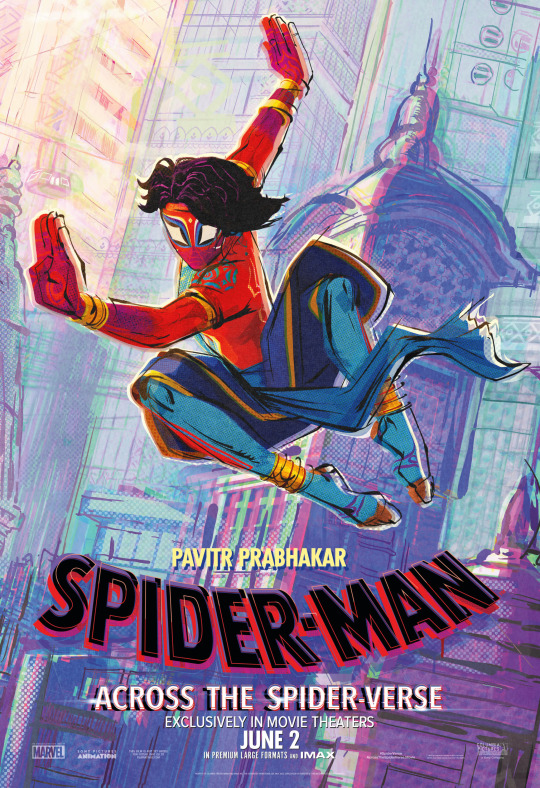
Just look at that design! So cool! So awesome! And so so Desi!!!
Its these desi aspects that I want to shed light on cos I know there are non-Indian fans who didn't catch a lot of the nuances cos they're not familiar enough with Indian culture and even Indian fans who didn't know about some details cos they aren't from the areas the inspiration for these elements were drawn from.
Mainly I hope to help artists and writers with this, so they have more information to create with, as well as the casual fans so they have more info and can immerse themselves better as well as appreciate just how much effort went into making this spectacular movie.
This might be a long post with me just rambling away so braze yourself people.
So lets get into it.
{WARNING: Infodump incoming}
First, lets start with the Mask
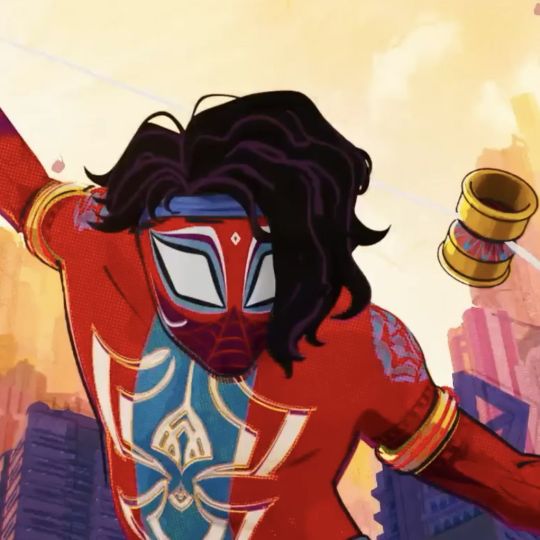
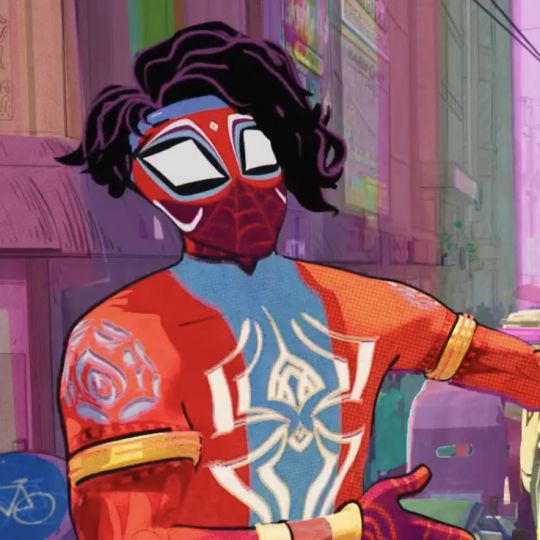
So here we have two different angles of his mask. The most prominent features of his mask are his eyes. There is a multi-layer outline for them in black, blue, red, and white, which of course are the classic spiderman colours but never quite used like this. Usually there is only a single outline in shades of, or adjacent colours of black, red, or white.
(Disclaimer: I'm not a 100% sure of this being actually the inspo behind the eyes. I'm pretty sure though, like 80%. So this has not been confirmed.)
The design for his eyes reminded me of one specific thing:
Koodiyattam, which is a 2000 year old ancient temple artform from the southern Indian state of Kerala. Koodiyattam is not just the only surviving Sanskrit theatre in the world, but it also includes elements of koothu, from the Sangam era, the golden age of Tamizh culture, and thus was declared by UNESCO as a Masterpiece of the Oral and Intangible Heritage of Humanity.
Below is a picture of a Koodiyattam performer.

Instantly you'll realize that this is a costume drama, with extensive makeup, and complicated dress, especially with regards to the headgear, and is overall similar to the Beijing opera, not in terms of make or design or performance, but rather in elaborateness of ensemble. Japanese art forms like Noh or Kabuki could also come to mind along with certain Balinese dances.
Here is another photo which will give you a better look.
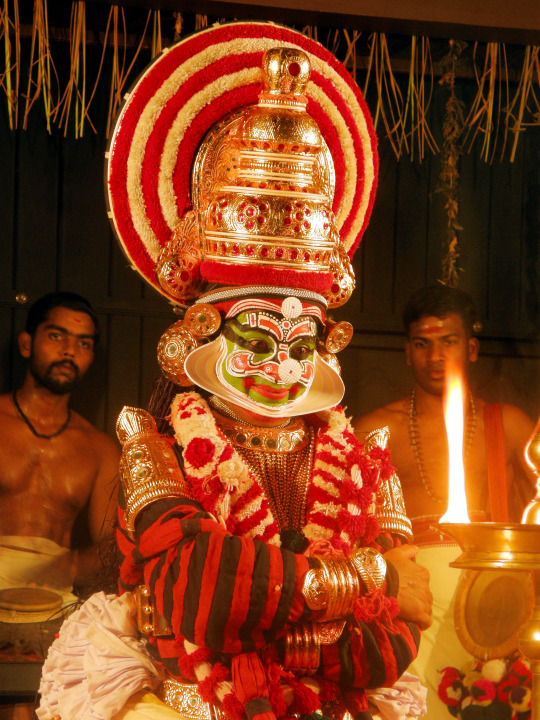
Notice the layered eye makeup in black, red, and white.
Here we have a closeup of a different performer where you can see it even more clearly.

The first time I saw Pavitr's eyes on screen, this is what immediately came to my mind as someone interested in traditional theaters of all kinds. Notice that Koodiyattam extensively uses reds and blacks, along with whites, which is also the colour palette that most spiderpeople choose, which is a cool coincidence. Blue is not that heavily used unlike the others however, but you can see it more in some costumes but generally not in makeup.
If we're talking less of what it reminded me of and more in terms of what the actual inspiration for the eye design probably was, it was most likely Kathakali, Koodiyattam's much younger, more well known, and very popular relative.
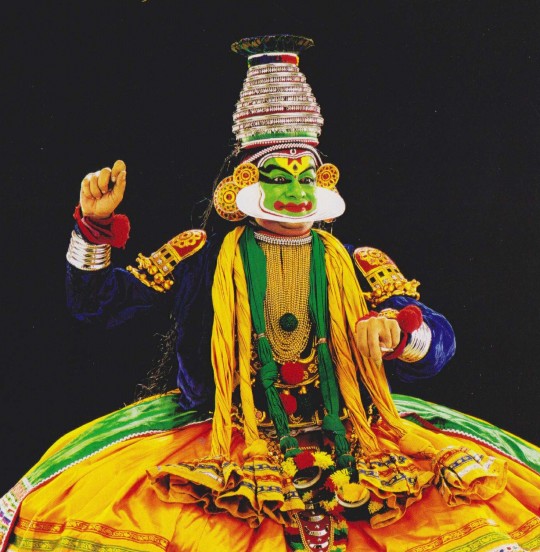
As you can see, Kathakali took its cues for costuming from Koodiyattam. (Actually it took its costuming cues from earlier art forms called Krishnattam, and Ramanattam, but they took it from Koodiyattam so it works.)
Again you can see the layered eye makeup, most prominently in black. (Cool fact, the costume and makeup changes according to the characters being portrayed on stage.)
Below is a picture of a Kathakali character with more elaborate eye makeup.
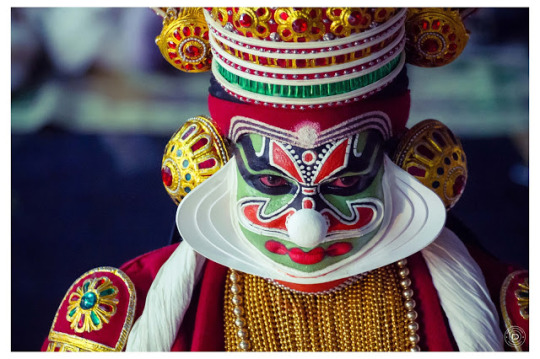
(I know a lot of you might think its the same makeup as Koodiyattam but I promise you its not. Inspired yes, same no.)
Because of the elaborate makeup and costume, expression can be a challenge so the art forms make maximum use of exaggerated body movements, hand signs, dance, lyrics etc. But the crowning element of acting in Koodiyattam and Kathakali are the eye techniques and how much simple eye movements can convey to the audience, which if you think about it, is also the case for spider-people. They're the most expressive superheroes in any medium, but they're fully covered so a lot of their expressiveness, both in comics and animation is conveyed through the shape of the eyes, body language, and speech. Another cool coincidence.
Below is a link to a short video which gives an brief overview of Kathakali and the importance of eyes in its performance.
youtube
This second link is a closeup of the eye movements of a female Kathakali character (women characters are called 'Minukku'). It shows how these highly trained artists can even move their eyes according to music. I have been told this can be uncomfortable to watch for some people so here's a warning for those who find eyeballs discomfiting.
youtube
And finally this one right here is a link to a short video on Koodiyattam.
youtube
{All three of these links are mainly aimed at people who find this sort of stuff interesting and want to check them out so if you're not, you can scroll past it, no big deal!}
(Oh man this is getting way too long and more like me gushing about traditional theatre than spiderman. Sorry about that.)
Now lets get back to our boy Pavitr. The second most noticeable feature of his mask is the curved, white line underneath his eyes, which gives off the impression of tusks. The first two pictures on this post already show the lines quite clearly but I'll attach one more angle.
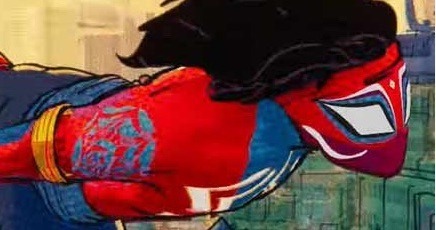
Something that immediately came to mind when I saw them was Theyyam but I wasn't sure until I saw this post.
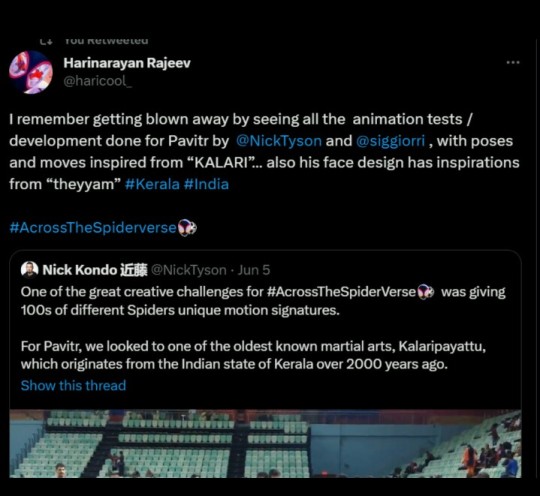
This was the same account that talked about how Pavitr's movements are inspired from Kalaripayattu so I was inclined to trust this. And after this one of the animators did confirm this so I was right on the money.
What exactly is Theyyam?
It is an ancient Hindu folk ritual practiced in northern Kerala, predominantly in the North Malabar region. Its origins can be traced back to the neolithic and chalcolithic eras. And unlike Koodiyattam and Kathakali which are associated with temples and the Koothambalam(temple theatre where temple artforms are performed), Theyyam is performed in the open air in Kaavu, the sacred groves of Kerala. The Theyyam performers become channels and vessels for the gods. Connect this to the 'Great Weaver'/ 'Master Weaver' who gave Pavitr his powers.
(Btw, these sacred groves are also ecological treasure troves and one of the ancient ways of nature preservation and they're really cool so check them out if you can.)
Below are two images of different Theyyams.

[Puliyoor Kali Theyyam]
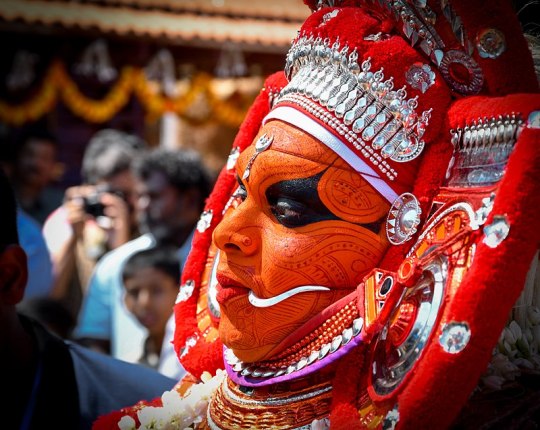
[Porrkali Theyyam]
See that on the cheeks? It resembles Pavitr's design closely right? While Pavitr's are drawn on his mask, these are singular metallic pieces, bound or clutched in the mouth to evoke the imagery and impression of tusks.
Theyyam is not alone in this particular imagery. A variety of folk arts use this, especially animism and folk rituals to show animal physical characteristics, as well as supernatural powers and elements.
For example, below is an image of Thirayttam, a ritual folk practice from the South Malabar region of Kerala. You can see the tusks here too. (Its not that clear, sorry about that.)
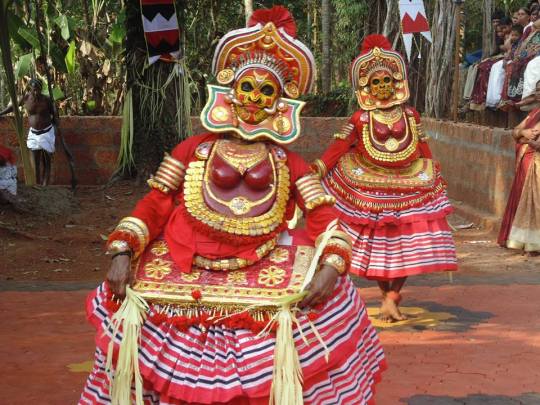
{Reminder: A lot of people think of Theyyam and Thirayattam as the same thing. While there are many similarities, with both being from the Malabar region, they are different practices. Theyyam is also called Tiṟa, and this is the main cause of the confusion but its not Thirayattam.}
Another example is Kalamezhuthu pattu, another religious folk art from Kerala. Mainly associated with the worship of the goddess Badhrakali, it is a sacred floor art done with powder and the result is called a Kalam. Below is a picture of a Kalam.

See those tusks? Yeah.
So they represent divinity, animal characteristics, inhuman powers etc.
[Interesting Info: Drawing Kalams are an integral part of Mudiyettu, a traditional ritual theatre and folk dance drama from Central Kerala. It is inscribed in the Representative List of the Intangible Cultural Heritage of Humanity. So do check it out if you're interested.]
{Oh my god I'm going off topic again. Come back bitch.}
To conclude, those lines are inspired by Theyyam markings, and stand for tusks and fangs, and as a spiderperson, who has the powers of a spider, gifted by some spiritual channel, its really apt that he was given such a design.
Next, lets talk about the lower half of Pavitr's mask.
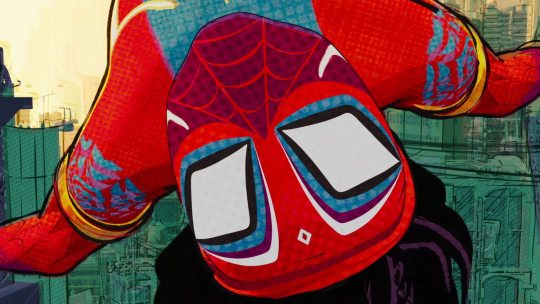
See those delicate red webs underneath the eyes?
This also reminded me of Theyyam. Its overshadowed by the more vibrant aspects of the costume, but a Theyyam's face has these intricate red patterns as well.

(Look at those eyes, reminds you of Pavitr's eye design right?)
And as you can see in this next image, after the headgear is put on, the designs mainly concentrate on the lower half of the face, much like Pavitr's mask.
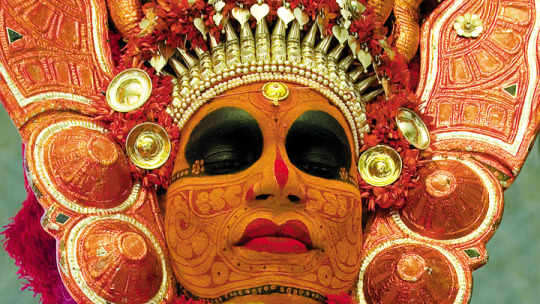
I admit I might be stretching this as web designs on the mask is a spiderman thing in general but I think I'm the pretty much on the dot on this one, and most likely its a combination of both.
[A 100% sure about that tusk thing though :)]
Also sometimes Theyyams would have these metallic eye coverings.

[Muchilot Baghavati Theyyam]
A closer look.

This is just my opinion but those silver eye masks kind of reminded me of the classic Spiderman eyes. Single colour, pupil-less, black outline, no idea how they see out of it etc. This one in particular reminded me of the classic spiderman especially with the eyes outlined in black like that.
Overall, the tusks, plus the thin web design on the mask, and the eyes, the spiderman red colour palette, they all evoked the image of Theyyam for me when I first saw Pavitr on screen.
{There is a very similar art form to Theyyam called Bhootakola in the coastal region of Karnataka, another southern Indian state. Those curious about Theyyam can check out the Kannada movie Kantara which deals with Bhootakola and you'll get an idea about Theyyam as well. The movie is awesome by the way. Watch it if you can.)
(This is getting way too long and image heavy. And I'm also going off tangent too much. Gotta wrap this up!)
Finally lets talk the last aspect of Pavitr's mask. This might actually be the feature that most of the non-Indian audience identified as Indian without anyone pointing it out.
I'm talking about the white, diamond shaped marking on Pavitr's forehead.
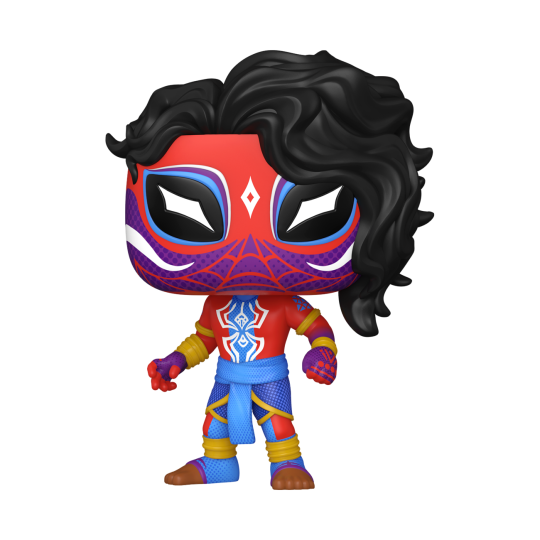
This decorative marking, bindi/pottu/tilaku, might actually be the most recognizable aspect of Indian culture across the world.
If you scroll back to all the previous images I provided, you can see some variation of this in all of them, either drawn on, or as an ornament. While there are some cultural differences in how they're worn, like women in southern India wearing them in all stage of life while their northern counterparts wear them only after marriage(I could be wrong about this, as I've seen children wearing them often, and things could've changed in modern times so please do correct me if I'm wrong), its one of the most common motifs you'll see across the country.
It can be a simple, round mark.

It can be ornamented.
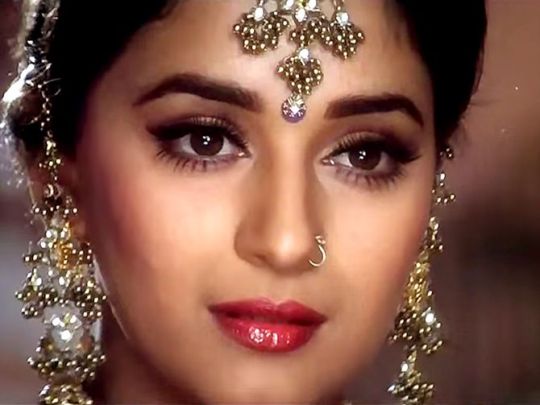
It can be a different shape altogether.
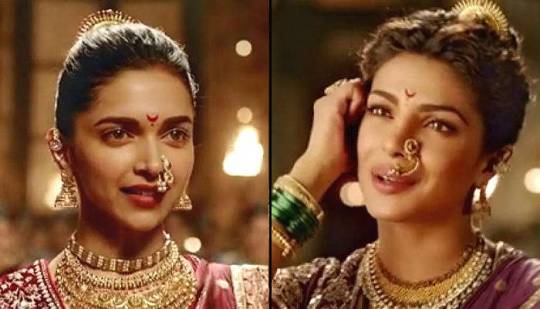
(From the musical sequence 'Pinga' in the Hindi film Bajirao Mastani)
A different colour.
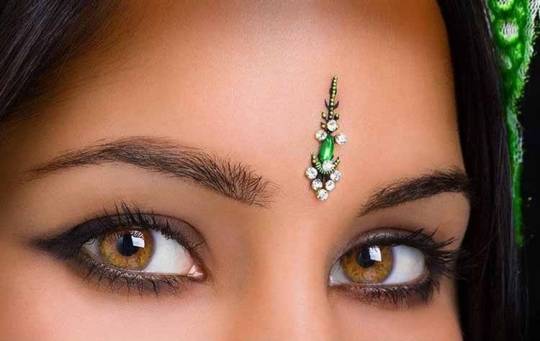
You get the idea.
Men can wear it as well. though styles and decoration maybe different.
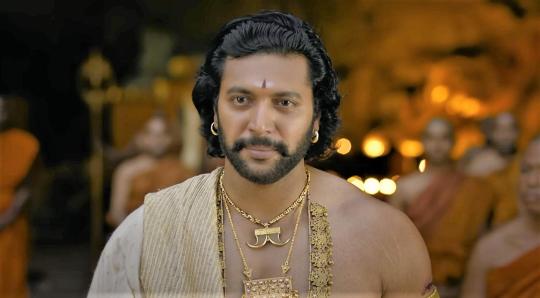
(From the Tamizh film Ponniyin Selvan 1)
A more modern version.
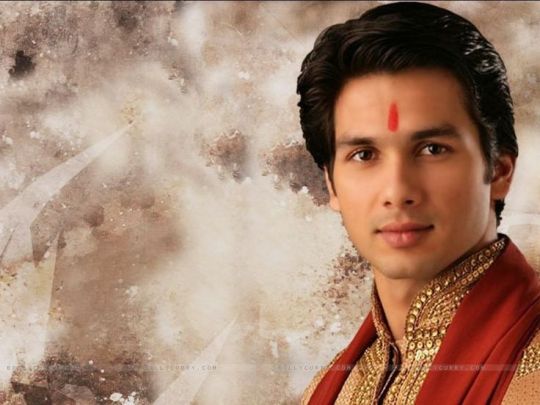
Geography wise, the bindi/pottu/tilak is predominantly seen in India, but its also found in other countries of the Indian subcontinent and neighbouring nations, as well as South-East Asia(as they were both part of the ancient Indosphere and had a past of Hindu Kingdoms. See: Srivijaya(Sriwijaya) empire, Indonesia).
Similar forehead markings were even common in China in the past. Those who have seen wuxia and xianxia dramas and movies definitely have seen them before and know what I'm talking about. (Huadian 花鈿)
Religion wise, its predominantly a Hindu motif, but its also part of Buddhist, Jain, Sikh, as well as several other indigenous religions.
{I've actually seen several Indian Christians and Muslims wear it as well, because its their culture, even if its not their religion.}
EDIT: Gaaaaah! I forgot to include this even though I'd intended to from the beginning.
This is not about the mask but some of the prototype designs for Pavitr so I thought I'll just talk about them a bit here.
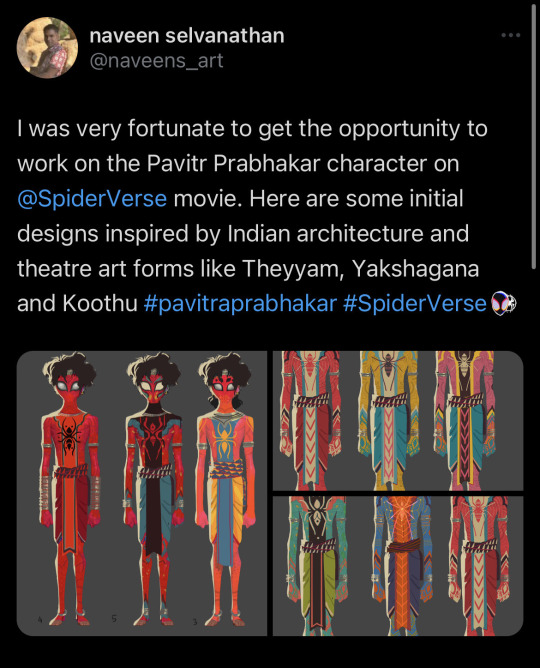
Again I can't believe all the effort that went into making this movie. Just look at those designs. Absolutely stellar and inspired. The colour palette itself is amazing.
Honestly everyone else just has no excuse anymore.
[I'll focus on the theatre aspect like I've been doing and talk about the architecture bit sometime else.]
This one is obviously the Theyyam inspired one.
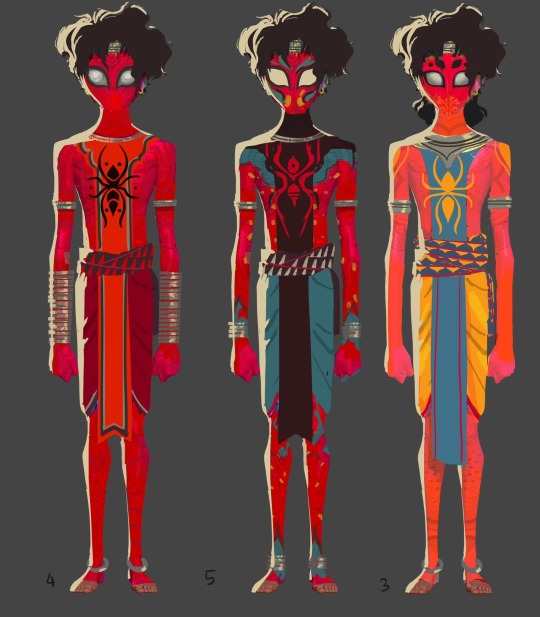
(Look at the eyes of 4 and 3, you can see they're inspired by the silver eye-mask I mentioned before. Also the headband is silver and looks similar to the bands securing a theyyam's headgear in place.)
A lot more Theyyam elements than what made it to the final cut. Especially the jewellery and the sharp-eyed among you must've already noticed the similarity between the necklaces of the design and the necklaces of the theyyams whose images I provided. The bangles and the anklets are also very distinctively Theyyam and they're called Katakam and Chutakam respectively but the final design seems to have made the bangles gold and more bracelet-like, and the anklets more like ankle-cuffs.
(I so badly wish the necklace stayed in but yeah that could've hindered movement.)
Now lets come to the Yakshagana inspired one.
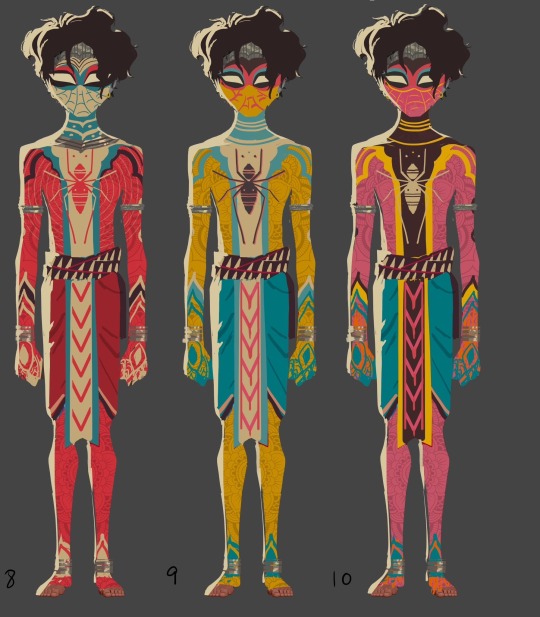
(Notice how the shape of the eyes have changed? And the colour palette took a turn? A lot more gold coming in.)
Yakshagana is a form of traditional theatre originating in modern day Karnataka state of India, and currently practiced in both Karnataka and Kerala. It is primarily an art form from the coastal Karnataka region and the neighbouring Kasargod district of Kerala.
Below is a link to more information on Yakshagana so you can take a look at the costuming and see the influences in the above prototype more clearly.
(I'm not gonna go into detail about all the design choices in the Yakshagana prototype, maybe in another post.)
Now lets come to the final prototype.
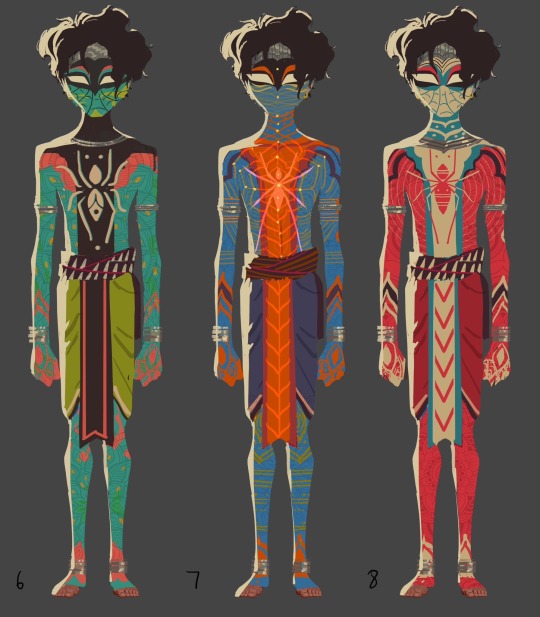
(Again the colour palette has shifted, a lot more greens and blues. I do believe that 8 is koothu and not Yakshagana even though it was included in the image above. I say that because of all the white in the design which is very distinctive of a kind of koothu as far as I'm aware.)
I actually already mentioned koothu once before in this post when I was talking about Koodiyattam in the very beginning. So lets go back to it.
Koothu is a folk theatre art that originated in early Tamizh country(Tamizhakam), and broadly speaking, its of two types, Terrukuttu, and Kattaikkuttu. It reached its peak in the golden age of Tamizh culture, the Sangam era and it mainly depicts scene from the epics. Currently types of Koothu are practiced in modern day Tamil Nadu and Kerala(Kerala was once part of ancient Tamizhakam).
Below is a link that will give you more info and an image of the costume with makeup similar to 6.
And this one is a link to a particular kind of koothu in Kerala known as Chakyar Koothu cos all the white on the make of prototype version 8 reminded me of it. (Also Chakyar Koothu is a form of social satire and criticism, it was basically ancient Stand-up comedy and the Chakyar is supposed to be really witty, which fits Spiderman to a T I gotta say.)
Again I'm not gonna go into further details and nuances of the design as this is a prototype design, maybe some other time. But I have to say that this colour palette does make Pavitr a lot more spideresque or evoke a more primal spider energy cos how it connects the viewer to jungle like and more animalistic environments more than the other designs.
And that's it for the mask and the prototypes everybody! Yay!
Holy shit that was long!
I'm gonna stop here for now cos this is already way too much. Can't believe I thought I'd be able to look through the entirety of Pavitr's design in one post. What was I on?
Seriously what kind of drug?
Anyway I'll be making a part 2 for this, looking through Pavitr's clothes and and movements and all. I say Part 2 but considering what happened with the mask I'm pretty sure it might go up to Part 3 or 4. Here's to hoping I learn some moderation by then lol.
(All the images are from google images and I have taken and have credit for exactly none of them. The verbiage is mine completely though.)
#Pavitr Prabhakar#Spiderman India#Indian spiderman#desi spiderman#spiderman atsv#character design#desi design#the desi-gn get it? I'll show myself out#across the spiderverse#spiderman: Into the Spiderverse#Spiderman: Across the Spiderverse#sony spiderverse#atsv#so much love and effort went into this movie and it shows#it was absolutely magnificent#character design inspiration#Indian culture#traditional theatre#traditional artforms#Theyyam#Koodiyattam#Kathakali#Yakshagana#Koothu#Tamil culture#Tamizh culture#Malayali culture#Kannada culture#tulu culture#tuluva culture
82 notes
·
View notes
Text
Art and Culture Trails: Discovering Kerala’s Rich Heritage
Introduction
Kerala, often referred to as "God's Own Country," is not only known for its natural beauty but also for its vibrant cultural heritage. With its classical dance forms, traditional music, ancient temples, and historical monuments, the state offers a captivating journey for culture enthusiasts. Whether you're a history buff, an art lover, or simply curious about Kerala’s traditions, the art and culture trails of Kerala Tourism 2025 are sure to leave you mesmerized.
1. Kathakali and Traditional Dance Forms
Experience the grace and grandeur of Kathakali, Kerala’s iconic dance-drama that combines elaborate costumes, vibrant makeup, and powerful storytelling. Other traditional performances like Mohiniyattam, Theyyam, and Koodiyattam are equally mesmerizing, offering a glimpse into the region’s cultural heritage. Head to cultural centers in Kochi, Thrissur, or Thiruvananthapuram for live performances.
2. Mural Art and Heritage Architecture
Kerala’s ancient temples and palaces are adorned with exquisite mural paintings that depict mythological tales and vibrant scenes from Hindu epics. The Mattancherry Palace in Kochi and Padmanabhapuram Palace are renowned for their impressive murals, making them must-visit destinations for art lovers.
3. Traditional Music and Festivals
Witness the soul-stirring rhythms of traditional Carnatic music and the rhythmic beats of Chenda Melam during temple festivals. Onam, Thrissur Pooram, and Vishu are celebrated with grandeur, featuring spectacular processions, traditional folk performances, and vibrant cultural events.
4. Handicrafts and Artisan Villages
Support local artisans and explore Kerala’s traditional crafts like coir weaving, handloom textiles, and bell metal work. Visit craft villages like Aranmula, known for its unique metal mirrors (Aranmula Kannadi), or Chendamangalam for authentic handwoven fabrics.
5. Culinary Heritage
Kerala’s culinary traditions are deeply rooted in its culture. From the traditional Sadhya served on banana leaves to delicious seafood delicacies, every dish tells a story of the region’s rich heritage. Don’t miss a traditional cooking experience to learn the secrets of Kerala’s authentic flavors.
Conclusion
Exploring the art and culture trails of Kerala Tourism 2025 offers an enriching experience that celebrates the state’s artistic legacy. From mesmerizing dance performances and ancient murals to vibrant festivals and traditional craftsmanship, Kerala’s heritage is a living testament to its cultural brilliance. Plan your journey and immerse yourself in the soulful charm of Kerala’s art and culture
0 notes
Text

Send from Sansgreet Android App. Sanskrit greetings app from team @livesanskrit .
It's the first Android app for sending @sanskrit greetings. Download app from https://livesanskrit.com/sansgreet
Guru Mani Madhava Chakyar.
Guru Mani Madhava Chakyar (15 February 1899 – 14 January 1990) was a celebrated master performance artist and Sanskrit scholar from Kerala, India, considered to be the greatest Chakyar Koothu and Koodiyattam (ancient Sanskrit drama theatre tradition) artist and authority of modern times. He was considered as the authority of Abhinaya (the classical Indian acting style) and Nātyaśāstra.
#sansgreet #sanskritgreetings #greetingsinsanskrit #sanskritquotes #sanskritthoughts #emergingsanskrit #sanskrittrends #trendsinsanskrit #livesanskrit #sanskritlanguage #sanskritlove #sanskritdailyquotes #sanskritdailythoughts #sanskrit #resanskrit #guru #manimadhavachakyar #chakyar #chakyarkoothu #koodiyattam #sanskritdrama #traditiondrama #natyasastra #kozhikkode #ottappalam #kerala #keralatradition #padmashri #natya #celebratingsanskrit
#greetingsinsanskrit#sanskritgreetings#sanskrittrends#trendsinsanskrit#livesanskrit#sanskrit#celebratingsanskrit#incredibleindia#indianarmy
0 notes
Text
Indian Culture of Theatre and Films : Article by: Dr. Anadi Sahoo is the Founder of Spiritual Bharat, a Spiritual Educational Institute where academic, social, and religious values are taught As of 2021, India had approximately 14,89,115 schools according to UDISE. The Government of India plans to utilize 9,742 cinema screens in the mornings to showcase audio-visual content about various states' museums and temples, targeting students from the 5th class and above. This initiative aims to enhance cultural awareness among students. India is a land of diversity. These diversifies have made the Indian culture a unique one. Evidence of drama culture was present in Vedic texts, as dramas were enacted during Yajna ceremonies like Purana Katha and Rama Lila etc. Theatre is the place where the culture of the people is displayed, be it dance, drama or music. Indian Music and dance is one of the most revered identities of our culture. Dance is the form of vibration of our body and mind. A national theatre should, therefore in the fitness of things, emit the fragrance of the cultural heritage of a nation and should, apart from its exterior loveliness, be in harmony with the atmosphere of the country and the traditions of its people;- like Ramlila, Krushnalila, Radhaprema lila, Bharata lila, Harikatha, Harischandra, Dandanata, Sakhinata, Chaiti Ghoda, Suanga, Ghudukinata, Baunsa Rani, Samaja, Bandinata, Bhanumati khela, Chhaunata, Maharinata, Sabda Swaranata, Desinata, Gotipua, Prahlad Natak, Pala, Daskathia etc. The origins of Indian Theatre, to date, are the subject of dispute and debate and widely believed that the art form finds its origins in Sanskrit drama and the works of Vyasa, Kalidasa, Shudraka, Vishakhadatta, Bhavabhutti and Harsha. Sanskrit drama’s period began in the 2nd century BCE and its end in the 10th century CE was marked by several foreign invasions and rulers that banned this art form, thus causing its decline. The essence of Sanskrit theatre, however, continued to live on in the southern part of India, especially in the form of Koodiyattam. The sculptures that teaches dance date back to the Indus Valley Civilization also portray dancing figures. Bharat Muni’s book Natya Shastra is the first famous source to mention dance. This text dates back to the 2nd century AD. In this text, the creation of dance is credited to Lord Brahma, who takes its knowledge from the four Vedas. India has various forms of dances including classical dances and folk dances. There are two basic aspects of Natya Shastra: Lasya ; It denotes grace, bhava, rasa and abhinaya. It is symbolic to the feminine features of dance as an art form and Tandava: This is symbolic to the male aspects of dance and has more emphasis on rhythm and movement. There are three basic elements: Nritta – These are the basic dance steps and are performed rhythmically but devoid of any expression or mood
0 notes
Text
Indian Culture of Theatre and Films : Article by: Dr. Anadi Sahoo is the Founder of Spiritual Bharat, a Spiritual Educational Institute where academic, social, and religious values are taught As of 2021, India had approximately 14,89,115 schools according to UDISE. The Government of India plans to utilize 9,742 cinema screens in the mornings to showcase audio-visual content about various states' museums and temples, targeting students from the 5th class and above. This initiative aims to enhance cultural awareness among students. India is a land of diversity. These diversifies have made the Indian culture a unique one. Evidence of drama culture was present in Vedic texts, as dramas were enacted during Yajna ceremonies like Purana Katha and Rama Lila etc. Theatre is the place where the culture of the people is displayed, be it dance, drama or music. Indian Music and dance is one of the most revered identities of our culture. Dance is the form of vibration of our body and mind. A national theatre should, therefore in the fitness of things, emit the fragrance of the cultural heritage of a nation and should, apart from its exterior loveliness, be in harmony with the atmosphere of the country and the traditions of its people;- like Ramlila, Krushnalila, Radhaprema lila, Bharata lila, Harikatha, Harischandra, Dandanata, Sakhinata, Chaiti Ghoda, Suanga, Ghudukinata, Baunsa Rani, Samaja, Bandinata, Bhanumati khela, Chhaunata, Maharinata, Sabda Swaranata, Desinata, Gotipua, Prahlad Natak, Pala, Daskathia etc. The origins of Indian Theatre, to date, are the subject of dispute and debate and widely believed that the art form finds its origins in Sanskrit drama and the works of Vyasa, Kalidasa, Shudraka, Vishakhadatta, Bhavabhutti and Harsha. Sanskrit drama’s period began in the 2nd century BCE and its end in the 10th century CE was marked by several foreign invasions and rulers that banned this art form, thus causing its decline. The essence of Sanskrit theatre, however, continued to live on in the southern part of India, especially in the form of Koodiyattam. The sculptures that teaches dance date back to the Indus Valley Civilization also portray dancing figures. Bharat Muni’s book Natya Shastra is the first famous source to mention dance. This text dates back to the 2nd century AD. In this text, the creation of dance is credited to Lord Brahma, who takes its knowledge from the four Vedas. India has various forms of dances including classical dances and folk dances. There are two basic aspects of Natya Shastra: Lasya ; It denotes grace, bhava, rasa and abhinaya. It is symbolic to the feminine features of dance as an art form and Tandava: This is symbolic to the male aspects of dance and has more emphasis on rhythm and movement. There are three basic elements: Nritta – These are the basic dance steps and are performed rhythmically but devoid of any expression or mood
0 notes
Text
A Platform for Young Koodiyattam Artists
Context: Cholliyattom is an informal collective of young Koodiyattam artists in Kerala, launched during the COVID-19 pandemic. This platform aims to bring together artistes from various schools of Koodiyattom to collaborate, preserve the art form, and learn the nuances of different styles. Preserving different Koodiyattam traditions: Cholliyattom plays a critical role in preserving various…
0 notes
Text
Indian classical dance 2024 visit here-https://indradigi.com/blog/

Indian classical dance
In Indian art and culture Indian classical dance is a dynamic art form that combines intricate rhythms, spirituality, and storytelling. It has its roots in India’s cultural legacy.
Every dance form, including Kathak, Odissi, Kuchipudi, Manipuri, Mohiniyattam, and Kathakali, has its own unique expressions, costumes, and movements. Dancers’ express emotions and stories through rhythmic footwork, facial expressions (abhinaya), and hand gestures (mudras), which are frequently drawn from religious texts and mythology.
These dances create a captivating fusion of visual and aural art that has been passed down through the generations. They are distinguished by their exact technique, intricate costumes, and strong connection to music.
Kathakali Indian classical dance In Indian art and culture
In the temples of Kerala, under the patronage of feudal lords, two forms of dance-drama, Ramanatam and Krishnatam, were developed, in which the story of Ramayana and Mahabharata was told, these folk drama traditions became the source of the emergence of Kathakali Indian classical dance,
the name is derived from Katha meaning story and Kali means drama. Koodiyattam (Sanskrit theatrical tradition) as well as other ancient martial arts exhibitions.
It is a wonderful combination of music, dance and drama. With the dissolution of the feudal system, Kathakali as a form of art began to emerge. It was revived in 1930 by the famous Malayalam poet V. N. Menon under the supervision of Mukunda Raja. Some of the characteristics of Kathakali Indian classical dance are written below:
Kathakali is usually performed by male troupes:
Kathakali is performed with the least use of support in the presentation. Head caps are used with superimposed make-up of faces for different letters. Different colors have their own significance:
Green indicates nobility, gods and virtue red spots next to the nose indicate majestic pride
Black is used to indicate versatility and vision. Yellow is for saints and women. A face painted entirely red indicates evil. White beard indicates beings with higher consciousness and divinity. It involves both dance and drama and the two are so combined that they cannot be clearly distinguished. Most of the Kathakali singing is a grand simulation of the eternal struggle between good and evil.
Its theme is stories narrated in epics and puranas. It is also called Purva ballads. The language used for Kathakali songs is a mixture of Manipravalam, i.e., Malayalam and culture. Music is important to convey the whole play correctly to the audience.
Various musical compositions are used while performing the play for depth. Gestures are the precious ornament of the whole dance-drama. Kathakali is written in the representation of rasa through the eyes and eye through which the story is communicated. The nine important facial expressions called Narvas are taught to express different emotions.
Extensive gestures are also used in the hand. Performing this dance form requires rigorous training. Kathakali is performed in an open theatre or temple complex covered with thick mats with lush green trees of Kerala providing a backdrop. Brass lamps are used for illumination. The arrival of dawn with the continuous sound of drums, holes and mandalas and the beginning and ending for the Kathakali rendition signifies the Kathakali element
Famous exponents: Guru Kunju Kurup, Gopinath, Kotakkal Sivaraman Rita Ganguly.
Mohiniyattam Indian classical dance In Indian art and culture
Mohiniyattam Indian classical dance or Mohini means beauty feminine and Attam means dance.The Indian classical dance is originally a dancer-solo, developed further by Vadivelu in the 19th century. It gained importance under the rulers of Travancore in the state of Kerala. Swathi Thirunal’s patronage is noteworthy. Having become obsolete, the famous Malayalam poet V.N. reviewed it with mana Kalyani Amma. Read More- https://indradigi.com/blog/
0 notes
Text
Blog 25 - FMP
The young boy character plays an instrument to enhance the powers of the old woman character. I decided to make the instrument a “chenda” which is a cylindrical percussion instrument commonly used in the southern states of India. This instrument is always used in accompaniment with the Theyyam performance. This instrument is famous for its loud and rigid sound. The Chenda is mainly played in Hindu temple festivals and as an accompaniment in the religious art forms of Kerala. The chenda is used as an accompaniment for Kathakali, Koodiyattam, Kannyar Kali, Theyyam, and among many forms of dances and rituals in Kerala. This is what I have referenced in my design for the young boy.

Chenda Kottu

FInal concept of the boy
Bibliography
JAGRUP SINGH SEKHON. (2020) Kalamandalam Unnikrishnan, The Hindu. Available at: https://www.thehindu.com/entertainment/music/in-conversation-with-kathakalis-top-chenda-player-kalamandalam-unnikrishnan/article30987892.ece
0 notes
Text
ART FORMS
For those who enjoy dance, theatre, music, and festivals, Kerala is a paradise. Kerala has numerous artistic disciplines that are particularly specific to the region, including Kathakali, Ottamthullal, Chakyar koothu, Krishnanattam, Koodiyattam, Padayani, Kalaripayattu, Pavakathakali, Theyyam, Velakali, Thiruvathirakali, and Kolkali.
To visit my page
0 notes
Text
"Unveiling the Incredible: A Spectacular Three-day Cultural Extravaganza at the Enchanting Sree Narayana Guru Cultural Complex"
The Department of Culture, through the Sree Narayana Guru Cultural Complex, will be hosting a three-day cultural festival from October 24th to 26th. The festival will feature various events such as Vidyarambham, a book fair, an anti-war film festival, folk music, fusion dance, Koodiyattam, Padayani, a painting camp, a heritage village exhibition, and a lecture series. M. Mukesh, MLA, announced…

View On WordPress
0 notes
Text
"Unveiling the Incredible: A Spectacular Three-day Cultural Extravaganza at the Enchanting Sree Narayana Guru Cultural Complex"
The Department of Culture, through the Sree Narayana Guru Cultural Complex, will be hosting a three-day cultural festival from October 24th to 26th. The festival will feature various events such as Vidyarambham, a book fair, an anti-war film festival, folk music, fusion dance, Koodiyattam, Padayani, a painting camp, a heritage village exhibition, and a lecture series. M. Mukesh, MLA, announced…

View On WordPress
0 notes
Text
"Unveiling the Incredible: A Spectacular Three-day Cultural Extravaganza at the Enchanting Sree Narayana Guru Cultural Complex"
The Department of Culture, through the Sree Narayana Guru Cultural Complex, will be hosting a three-day cultural festival from October 24th to 26th. The festival will feature various events such as Vidyarambham, a book fair, an anti-war film festival, folk music, fusion dance, Koodiyattam, Padayani, a painting camp, a heritage village exhibition, and a lecture series. M. Mukesh, MLA, announced…

View On WordPress
0 notes
Text
Bhasha Sumbli: A Multifaceted Rising Star in Indian Cinema
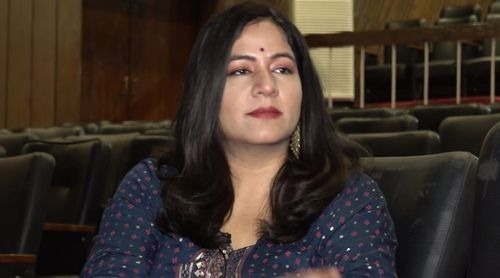
Hello, Tumblr cinephiles! Are you ready to be swept off your feet by an awe-inspiring talent? Let me introduce you to Bhasha Sumbli, an emerging powerhouse in Indian cinema1. Born in 1991 in Srinagar, Jammu and Kashmir, Bhasha hails from the Kashmiri Pandit community and has grown up around the literary world, thanks to her poet parents Kshama Kaul and Agnishekhar Pandit.
Embarking on an artistic journey, Bhasha began her career in theatre after studying at the National School of Drama and learning Koodiyattam, an ancient Indian classical dance style. She went on to work with Moti Lal Khemu, a prominent figure in Kashmiri folk theatre. Her dedication to her craft led her to receive the prestigious Inlaks Theatre Award in 2014.
Bhasha's acting journey expanded to the silver screen, following her education at Anupam Kher's Actor Prepares in Mumbai. In 2020, she landed her first film role in 'Chhapaak' but caught the spotlight as Sharda Pandit in Vivek Agnihotri's 'The Kashmir Files'. Her television debut was in the Sony series 'Mere Dad Ki Dulhan,' and since then, she has been climbing the ladder of success.
But that's not all. Bhasha Sumbli's versatility extends to mentoring and coaching, helping actors in TV reality shows like 'India's Best Dramebaaz 2' (2015) and 'Sabse Bada Kalakar' (2016). She also writes insightful articles on ancient and popular theater forms.
0 notes
Text

Send from Sansgreet Android App. Sanskrit greetings app from team @livesanskrit .
It's the first Android app for sending @sanskrit greetings. Download app from https://livesanskrit.com/sansgreet
Guru Mani Madhava Chakyar.
Guru Mani Madhava Chakyar (15 February 1899 – 14 January 1990) was a celebrated master performance artist and Sanskrit scholar from Kerala, India, considered to be the greatest Chakyar Koothu and Koodiyattam (ancient Sanskrit drama theatre tradition) artist and authority of modern times. He was considered as the authority of Abhinaya (the classical Indian acting style) and Nātyaśāstra.
#sansgreet #sanskritgreetings #greetingsinsanskrit #sanskritquotes #sanskritthoughts #emergingsanskrit #sanskrittrends #trendsinsanskrit #livesanskrit #sanskritlanguage #sanskritlove #sanskritdailyquotes #sanskritdailythoughts #sanskrit #resanskrit #guru #manimadhavachakyar #chakyar #chakyarkoothu #koodiyattam #sanskritdrama #traditiondrama #natyasastra #kozhikkode #ottappalam #kerala #keralatradition #padmashri #natya #celebratingsanskrit
#greetingsinsanskrit#sanskritgreetings#sanskrittrends#trendsinsanskrit#livesanskrit#sanskrit#celebratingsanskrit#incredibleindia#kerala
0 notes